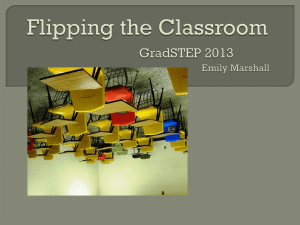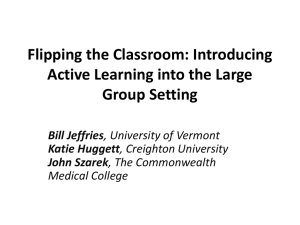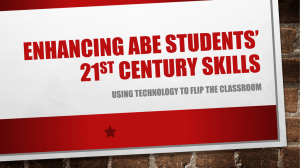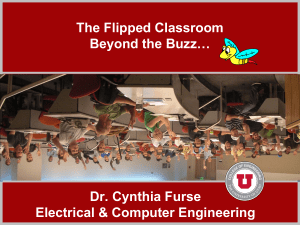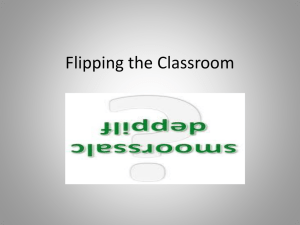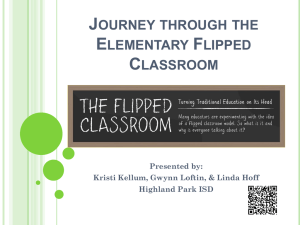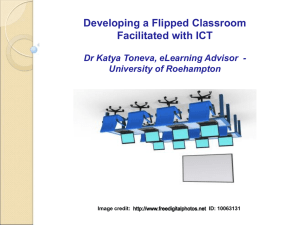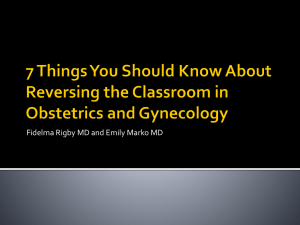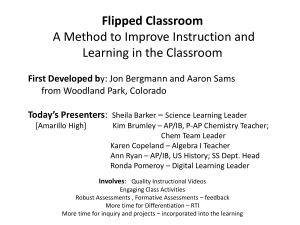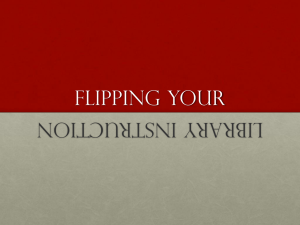Design a flipped class - University of Waterloo
advertisement
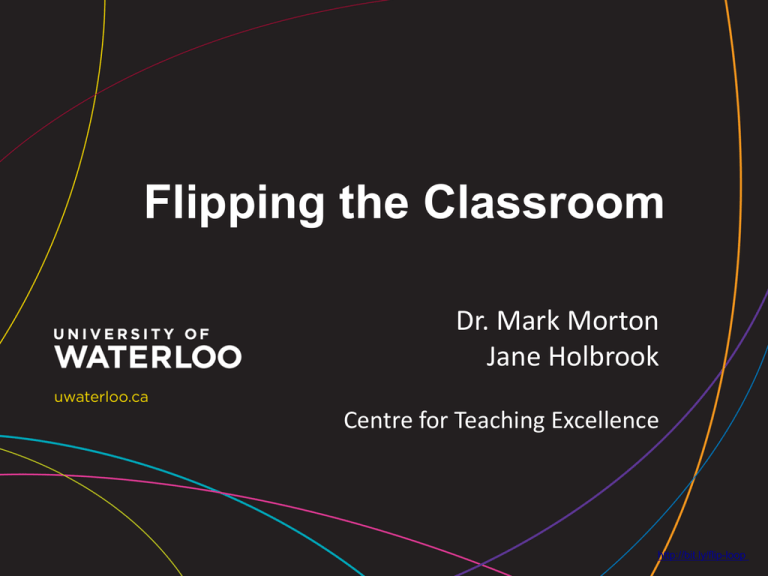
Flipping the Classroom Dr. Mark Morton Jane Holbrook Centre for Teaching Excellence http://bit.ly/flip-loop Our plan for this morning: • Engage you in a flipped class experience • Identify what makes a class a “flipped” class • Discuss the advantages and challenges of teaching a flipped class • Design a flipped class experience and identify technologies, in class learning activities and assessments that could be used • Identify which concepts might be taught more effectively in a flipped class in one of your courses Mark’s video http://youtu.be/k6M3VqxFVOI What is a “Flipped Classroom”? http://youtu.be/26pxh_qMppE Why might we want to do this? Discuss the advantages and challenges of teaching a flipped class with three other people. Model Flipped Class Stages and Considerations • Set the stage for learning by introducing the out of class task • Communicate clear expectations such as why you want them to do it, how long it will take and importance of preparation for inclass activity • Consider appropriate time commitment and degree of challenge for the students Introduce Task Out of Class Task • Consider choice of media carefully • Create your own materials or pull in outside resources • Create guiding questions or prompts for students as they engage in the task • Include a way for students to submit questions about difficult concepts to facilitate JITT • Check for evidence of preparation for in-class activity • Self assessment quizzes online can include questions that provide information about students’ conceptual understanding and provide formative feedback • Low stakes assessment at the beginning of class can motivate preparation Assess Learning Motivation In-Class Activity • Activities are linked to course objectives and assessments • Peer-to-peer and student-instructor dialogue is encouraged • Include opportunities for collaboration, peer learning in a low risk environment • Scalable application activities (discussion, problem solving, exploration) Screencasting Tools • Refer to the list Mark compiled on this CTE Teaching Tip Sheet. Design a flipped class Use the handout that Mark and Jane will distribute during the workshop as a template. Final words • Start small – flip a couple classes to start • Make the learning meaningful Other Resources • • • • • • • • • • • • • “The Flipped Class Revealed”. http://www.thedailyriff.com/articles/the-flipped-class-what-does-a-good-one-look-like692.php “7 Things You Need to Know about Flipping the Classroom.” A white paper from Information Technology Services at Penn State University. http://tlt.its.psu.edu/files/2011/09/2011-Flipping-the-Classroom.pdf “How Flipping the Classroom Can Improve the Traditional Lecture.” Dan Berret. Chronicle of Higher Education. http://chronicle.com/article/How-Flipping-the-Classroom/130857/ (this link only works if you are on a uWaterloo network). “Exploding the Lecture.” Steve Kolowich. Inside Higher Ed. http://www.insidehighered.com/news/2011/11/15/professortries-improving-lectures-removing-them-class Many amazing resources on flipped classroom strategies from the “Turn to Your Neighbour - Peer Instruction Blog.” http://blog.peerinstruction.net/?s=flipped , especially see the “7 Myths” http://blog.peerinstruction.net/7-myths-about-theflipped-classroom-debunked/ “Let's Use Video to Reinvent Education.” Salman Khan (the founder of the Khan Academy). A 20-minute video of a Ted Talk. http://www.ted.com/talks/salman_khan_let_s_use_video_to_reinvent_education.html “Five Best Practices for the Flipped Classroom.” Andrew Miller. Edutopia. http://www.edutopia.org/blog/flipped-classroombest-practices-andrew-miller “Flipping for Beginners.” Dave Saltman. Harvard Education Letter. http://www.hepg.org/hel/article/517#home “Confessions of a Converted Lecturer.” Eric Mazur. A 5-minute YouTube video. http://youtu.be/hbBz9J-xVxE “Flipped Training Introduction” by Katie Gimbar. A three-minute YouTube video : http://youtu.be/_6Z_77fSjGo “How do you do make your videos?” by Katie Gimbar. http://youtu.be/Icn8kMoH28Y Derek Bruff's blog on "Flipping Out". http://derekbruff.org/?p=2108 “Flipping a Class” University of Texas - http://ctl.utexas.edu/ctl/node/320 Active Learning • Students involved in more than listening • Less emphasis placed on transmitting information , more on developing students’ skills • Students are involved in higher-order thinking (analysis, synthesis, evaluation) • Students are engaged in activities (e.g reading, discussion, writing, presenting) • Greater emphasis placed on students’ exploration of their own attitudes and values Bomwell and Eisen (1991) Active Learning : Creating excitement in the classroom p2. One must learn by doing the thing, for though you think you know it-- you have no certainty until you try. (Sophocles, 5th c. B.C.) Considerations/potential challenges when decided to Flip • Strategies need to be devised to ensure students actual ingest content outside class - online pre-class assessment to assess concept understanding - in class low stakes quiz to ensure preparation - in class activity that requires preparation • Don’t re-lecture: if students come to class unprepared move forward anyway • May need to decrease content • Challenge of large class (not all active learning strategies feasible) • Students resist change from lecture approach (lecture easy for them) • It is hard not to lecture! Time/effort required to rethink and prepare both pre-class and in-class activities • Thoughtful consideration of technology (tool, content, format) • What else? Evidence that active learning works Classics: Hake, (1998) Interactive-engagement versus traditional methods: a six-thousand-student survey of mechanics test data for introductory physics courses. Am J Phys. 66, 64–74. Prince, (2004) Does Active Learning Work? A Review of the Research. J of Eng Edu, 93, 223-231. Recent Science: Deslauriers et al., (2011) Improved learning in a large-enrollment Physics Class. Science 332, 862-864 Tsaushu et al., (2012) Peer learning and support of technology in an undergraduate biology course to enhance deep learning. CBE – Life Sciences Education 11, 402-412 Haak et al., (2011) Increased structure and active learning reduce the achievement gap in introductory biology. Science 332, 1213-1216 Crouch and Mazur (2001) Peer instruction: ten years of experience and results. Am. J. Physics 69, 970-976 *Andrews et al., (2011) Active learning not associated with student learning in a random sample of college biology courses. CBE – Life Sciences Education 10, 394-405

